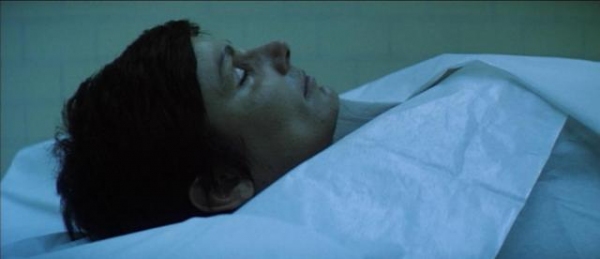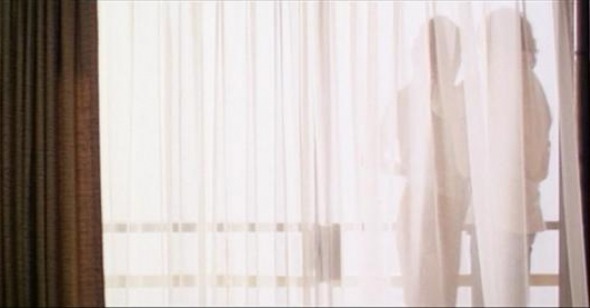Cut Short
Vicente Rodriguez-Ortega on The Parallax View
When one thinks about Alan J. Pakula’s 1970s conspiracy trilogy—Klute, The Parallax View, and All the President’s Men—the first thing that comes to mind is Gordon Willis’s superb visual work. Going against the grain of Hollywood’s standardized lighting schemes, Willis favored extremely low-key tableaux, lighting the actors from the top and using practical lights to envelop his characters in haloes of darkness. For they were in a place where they could not see, often acting as the pawns of more powerful forces that remained unearthed, under a surface the individual could barely scratch. Willis had famously pioneered this approach to visual storytelling in The Godfather, keeping the Mafiosi’s eyes within the realm of the shadows, preventing the spectator from reading or predicting the next step of the Corleones’ violence-driven reign of criminality. Although All the President’s Men provides a light at the end of the tunnel, highlighting the two second-tier journalists who shook down the U.S. government, the two first installments have a murkier tone. Klute centered on an escort girl suddenly trapped in the obscene sexual perversion of a sleazy and murderous tycoon, whose all-around ability to map out the range of visibility is represented through the innocuous grandiosity of his Panoptic office. The Parallax View aims higher. It is perhaps the ultimate American film to literally narrativize Eisenhower’s infamous warning against the military industrial complex.
In The Parallax View, reporter Joseph Frady (Warren Beatty) starts a crusade to unveil the maneuvers of “The Parallax Corporation,” a sinister organization that delivers hitmen to the highest bidder and has been intervening in American politics by sending would-be senators to the coffin in carefully orchestrated assassinations. Throughout the film, we remain tied to Frady’s restricted point of view, following his investigation as he poses as a wannabe hit man for the Parallax Corporation and seems to successfully infiltrate their ranks. The closing sequence, a 12-minute tour de force detailing the assassination of Senator John Hammond, a leading candidate for the upcoming presidential election, tells us otherwise. A Parallax Corporation hit man turns Frady into a corpse in the dark alleys of a catwalk above the warehouse where Hammond has been shot. Frady is framed as Hammond’s assassin—and so it will remain in the history books.
![]() Pakula and Willis visually anchor Frady’s inability to see his own fatal destiny in a series of surfaces that reflect outward, constantly frustrating our access to the actual workings of the puppeteers behind the grand conspiracy that rules U.S. politics. Framing Frady as a miniscule body at the threshold of gigantic steel and glass edifices that promise answers that are never given, Pakula and Willis situate the spectator within a space of ignorant confusion, ready to believe that Frady might actually succeed only to be eventually rewarded by his cold-blooded murder. The Parallax View seems to tell us that representational democracy is nothing but a duping fantasy framework to make us feel as acting players in the country’s governance. Others do the actual work. The Parallax Corporation rules almighty. And to reinforce this, a highly elliptical editing style is utilized, every twenty minutes or so, reminding the spectator of who’s pulling the strings.
Pakula and Willis visually anchor Frady’s inability to see his own fatal destiny in a series of surfaces that reflect outward, constantly frustrating our access to the actual workings of the puppeteers behind the grand conspiracy that rules U.S. politics. Framing Frady as a miniscule body at the threshold of gigantic steel and glass edifices that promise answers that are never given, Pakula and Willis situate the spectator within a space of ignorant confusion, ready to believe that Frady might actually succeed only to be eventually rewarded by his cold-blooded murder. The Parallax View seems to tell us that representational democracy is nothing but a duping fantasy framework to make us feel as acting players in the country’s governance. Others do the actual work. The Parallax Corporation rules almighty. And to reinforce this, a highly elliptical editing style is utilized, every twenty minutes or so, reminding the spectator of who’s pulling the strings.
When Lee Carter, a fellow reporter and ex-lover, visits Frady to tell him that her life is in jeopardy, Frady stops short of laughing at her. She proceeds to inform him that four of the people who witnessed the murder of senator Charles Carroll have already “accidentally” died. She is afraid that she will be next. Frady attempts to convince her that she is under a stressful paranoia attack and that there’s nothing to fear. Frady’s dismissal angers her. Unable to convince him despite showing him factual evidence to support her claim, she walks out of the living room, onto the porch. Frady follows her out and attempts to calm her down, hugging her. The minimalist notes of Michael Small’s score kick in. The narrative has come to a poetic stall, capturing from a distance an intimate moment of two estranged lovers. Cut. Carter’s corpse stares at the spectator in a close-up. Her skin bears the unmistakably greenish color of death. Willis’ camera dollies out to reveal that she is the morgue. The unaffected voice of a doctor informs Frady that she took way too many pills to drive a car. Some people ask for their own deaths. Frady stands in front of her body and walks out as the camera keeps dollying out to reveal a trashcan on the left corner. She has been dispatched.
![]() The shocking realization of Carter’s sudden death is the first instance of the key structural editing principle that reveals the workings of the Parallax Corporation: an abrupt elliptical cut that invariably leaves a corpse behind. This is also how Austin Tucker—a political figure trying to uncover the conspiracy—and Frady’s boss become lifeless. In all cases, Small’s punctuating instrumental score is recalled to complement the ruthless editing approach, which gives the spectator entrance to the true mechanisms through which the land of freedom and democracy becomes stained by murder and corruption. If Willis’s cinematography provides the backbone of the paranoid state U.S. social life entered following JFK’s assassination, the editing in the film is mobilized to reveal that, yes, we should indeed be paranoid. And there is no way to strike back. Otherwise, Parallax Corp. will get to us. The shocking heartlessness of The Parallax View’s “murder cuts” acts as proof.
The shocking realization of Carter’s sudden death is the first instance of the key structural editing principle that reveals the workings of the Parallax Corporation: an abrupt elliptical cut that invariably leaves a corpse behind. This is also how Austin Tucker—a political figure trying to uncover the conspiracy—and Frady’s boss become lifeless. In all cases, Small’s punctuating instrumental score is recalled to complement the ruthless editing approach, which gives the spectator entrance to the true mechanisms through which the land of freedom and democracy becomes stained by murder and corruption. If Willis’s cinematography provides the backbone of the paranoid state U.S. social life entered following JFK’s assassination, the editing in the film is mobilized to reveal that, yes, we should indeed be paranoid. And there is no way to strike back. Otherwise, Parallax Corp. will get to us. The shocking heartlessness of The Parallax View’s “murder cuts” acts as proof.

